Unidentified - Caribbean and South America (Atlantic)
A place for temporarily storing messages about Caribbean & S. America (Atlantic) species until they are identified. See Unidentified -General Page for an index of unidentified categories. Please make a point of looking through these messages to see if you can help identify any of them.
Authorship detailsRudman, W.B., 2001 (June 26) Unidentified - Caribbean and South America (Atlantic). [In] Sea Slug Forum. Australian Museum, Sydney. Available from http://www.seaslugforum.net/find/unidentcar
Related messages
Opisthobranch from Veracruz, Mexico
September 3, 2008
From: Rodrigo J. Pérez Weil
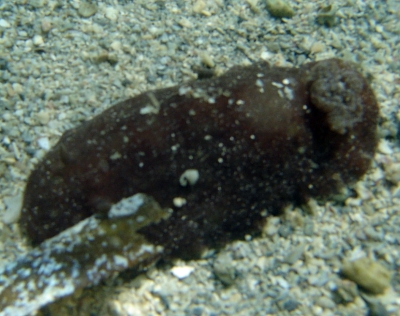
Concerning message #20925:
Dear Bill:
I photographed this opistobranch in Veracruz, Mexico, on a reef named La Galleguilla. It was about 1-2 m deep over coral rocks. Its size is 40 mm long. Can anyone help me about this opisthobranch? It can retract rhinophores and its gills too
Locality: Veracruz, 1-2 m, Veracruz, Gulf of Mexico, 30 may 2007. Length: 40 mm. Photographer: Rodrigo Pérez.
Rodrigo Pérez.
hitlacoke@hotmail.com
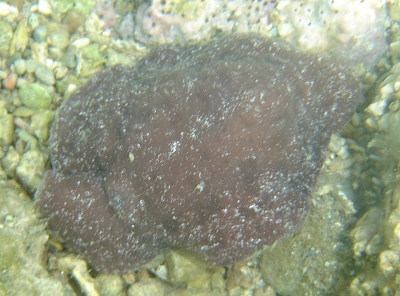
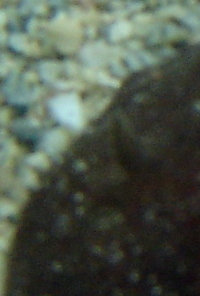
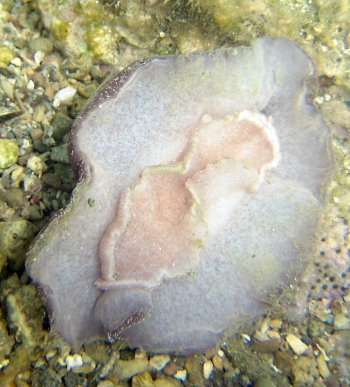
Dear Rodrigo,
It is a dorid nudibranch of some sort. My first thought was perhaps a Discodoris but I have my doubts. In one photo I noticed what look like papillae over the mantle [see middle right photo], which you wouldn't find in a Discodoris. I am afraid that in all parts of the world these 'flat' dorids are very difficult to identify from photographs - and often from living animnals as well - withour a good knowledge of the local fauna. Perhaps someone can help us?
Best wishes,
Bill Rudman
Opisthobranch from Yucatan, Mexico
November 6, 2007
From: Jazmin Ortigosa
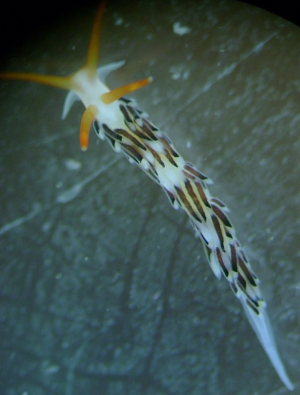
Dear Bill,
I have collected one specimen of this opisthobranch in Yucatan , Mexico . It was about 18 m deep over an algae from the genus Padina, although I don't think there is any dietary relationship.. It size is 14 mm long. Can anyone give me any clue on what can it be?
Locality: Yucatan, 18 m, Mexico, Gulf of Mexico, 06 June 2007. Length: 14 mm. Photographer: Jazmin Ortigosa.
Best regards,
Jazmin Ortigosa
jazmindeneb@hotmail.com
Ortigosa, J., 2007 (Nov 6) Opisthobranch from Yucatan, Mexico. [Message in] Sea Slug Forum. Australian Museum, Sydney. Available from http://www.seaslugforum.net/find/20925Dear Jazmin,
I have the feeling I have seen a photo of this before but unfortunately I can't remember where. It looks as though it is probably an aeolid of the phidianid/facelinid group but I can't find an appropriate name. Perhaps if it has a name someone will recognise it for us.
Best wishes,
Bill Rudman
Re: Pauleo jubatus? from St. Vincent Islands?
December 14, 2005
From: Philip Cromwell
Dear Bill,
This animal [message #15440] has many similarities to the Forum's "Flabellina sp. 2", including the conical white tipped rhinophores, median line forking onto the relatively short oral tentacles, reddish cerata with white spots and white tips, and opaque bands along the sides of the body. The main difference I can see is that the bands are yellow instead of white.
Hope this helps!
Cheers,
Phil
chiron42@sbcglobal.net
Cromwell, P. A., 2005 (Dec 14) Re: Pauleo jubatus? from St. Vincent Islands?. [Message in] Sea Slug Forum. Australian Museum, Sydney. Available from http://www.seaslugforum.net/find/15463Dear Phil,
There are certainly some similarities. Perhaps Sandra Millen can give us some more information on variation in Flabellina sp. 2.
Best wishes,
Bill Rudman
Pauleo jubatus? from St. Vincent Islands?
December 12, 2005
From: Les Wilk
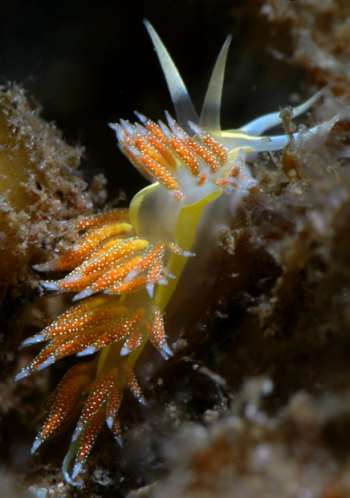
Hi Bill;
Could this be a Pauleo jubatus? Humann and Deloach ("Reef Creature Identification ") describe it as orange with white speckles, but their photo looks quite different from ours.
Locality: West side, St. Vincent Island, Caribbean. Depth: 60-70 feet. Length: .25-.50 inch. July 2005. Sargassum on sandy slope. Photographer: Keri Wilk
Les Wilk
wilk@reefnet.ca
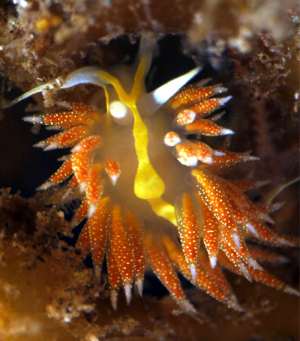
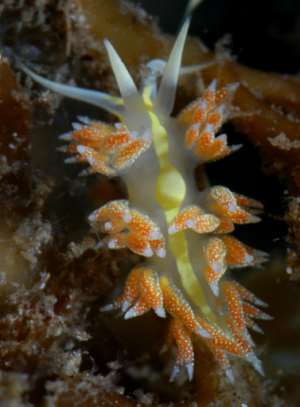
Dear Les,
It has some similarities to Pauleo jubatus but differs in colour, the arrangement of the cerata, and the shape of the cerata. Pauleo jubatus has a creamy white line of irregular width, and sometimes broken, down the dorsal midline. Your animal has a broad yellow band down the dorsal midline than forks on the head to give a branch to each oral tentacle. It also has a broad yellow band down each side of the body below the cerata. In Pauleo jubatus the tip of each ceras is usually twisted so it sits pointing vertically, a feature not seen in your photos. Another possible difference is that P. jubatus is found on the gorgonian Plexaurella dichotoma, on which it feeds. Your mention of finding your animal on Sargassum suggests it is possibly a hydroid feeder rather than a gorgonian feeder.
I may be wrong but I can't find any described species description to fit your animal but someone with a personal knowledge of the Caribbean fauna can give us some ideas.
Best wishes,
Bill Rudman
Flabellina sp. from St. Vincent
December 2, 2005
From: Les Wilk
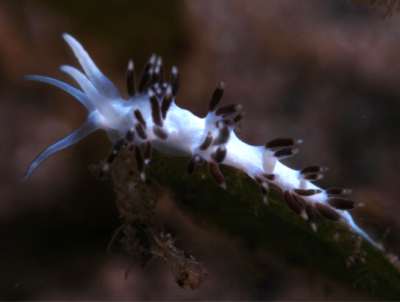
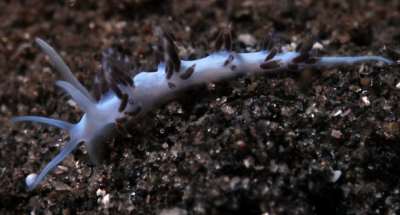
Hi Bill;
This one is from our 2005 St. Vincent field trip. Apparently a Flabellina sp., but I'm not sure which one.
Locality: west side St. Vincent Is., Caribbean. Depth: 15 feet. Length: 0.5 inches, July 2005. sandy bottom. Photographer: Keri Wilk
Les Wilk
wilk@reefnet.ca
Wilk, L., 2005 (Dec 2) Flabellina sp. from St. Vincent. [Message in] Sea Slug Forum. Australian Museum, Sydney. Available from http://www.seaslugforum.net/find/15372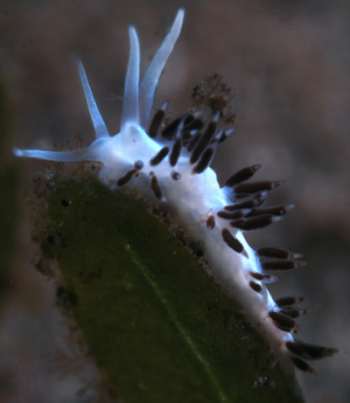
Dear Les,
This could well be a species of Flabellina. The anterior foot corners appear to be tentacular, and the first two groups of cerata on each side seem to be arranged in arches. I can't find anything that defintiely fits in the literature but perhaps someone will recognise it. Interestingly, it does have some similarities to the Mediterranean Piseinotecus gabinierei but the anterior ceratal groups don't seem to be on common stalks, althought the rhinophores show signs of wrinkles. I guess this is another one that needs an anatomical investigation.
Best wishes,
Bill Rudman
Unknown dorid from the Caribbean
July 19, 2005
From: Sean Kearney
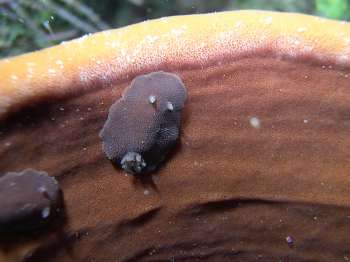
Dear Bill:
I got this pic the other night while on a dive at Cayman Brac. There were several of these dorids feeding on a vase sponge.There were a few white ones, juveniles I believe. I do have a picture, but not very clear.
Locality: Charley's Reef., Cayman Brac, Caribbean. Depth: 30 ft. Length: 1/2 to 3/4 inch. 15 July, 2005. Just prior to Hurricane Emily. Photographer: Sean Kearney
Can you please help identify it? Thanks for a terrific site.
Regards,
Sean Kearney
skearney@dc.rr.com
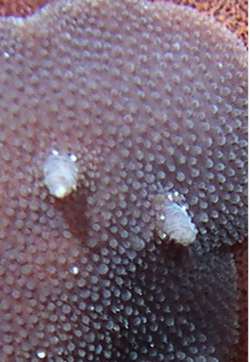
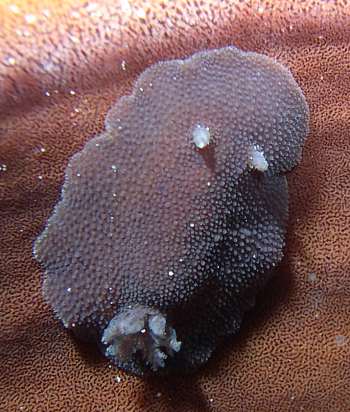
Dear Sean,
I can't identify it off hand. There are quite a few nodulose dorids described from the Caribbean from very few, often preserved animals so identifying luve animals from photographs is very difficult, and will remain so until we have a better idea of the fauna. If we are lucky someone may recognise it from their research
Best wishes,
Bill Rudman
Aeolid from Florida
January 28, 2005
From: Kelly Kingon
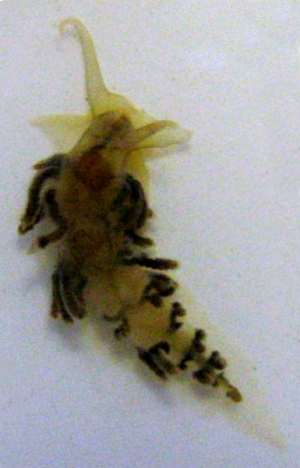
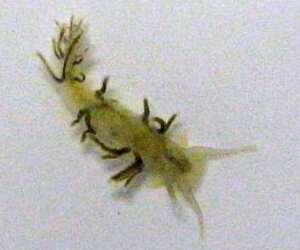
Here are pictures of two nudibranchs caught in different locations on different days. They looked different to me but maybe they are actually the same species. Any help with their identification would be great. Thanks!
Locality: St. Vincent Sound, Indian Pass, Florida, USA. Gulf of Mexico
Depth: 3 meters. Length: 10-15 mm. 11 January 2005
Bay Pass, muddy lots of algae covered in bryozoans
Photographer: Kelly Kingon
Thanks
Kelly Kingon
zayla_21k@yahoo.com
Kingon, K., 2005 (Jan 28) Aeolid from Florida. [Message in] Sea Slug Forum. Australian Museum, Sydney. Available from http://www.seaslugforum.net/find/12944Dear Kelly,
It's definitely an aeolid, although the green colouration makes you think of a sacoglossan. Unfortunately I don't know the species, but with luck someone will recognise it for us
Best wishes,
Bill Rudman
Re: Okenia? from Gulf of Mexico
February 19, 2004
From: Juan Lucas Cervera
Dear Bill,
Kelly Hooper's animal [#12174] resembles to me Okenia aspersa, but a better photograph would be very useful.
Regards,
Lucas.
lucas.cervera@uca.es
Cervera, J.L., 2004 (Feb 19) Re: Okenia? from Gulf of Mexico. [Message in] Sea Slug Forum. Australian Museum, Sydney. Available from http://www.seaslugforum.net/find/12242Thanks Lucas,
It certainly looks Okenia-like and it certainly looks like photos I have seen of Okenia aspersa. As you say, we need more information
Cheers,
Bill Rudman
Okenia? from Gulf of Mexico
February 14, 2004
From: Kelly Hooper
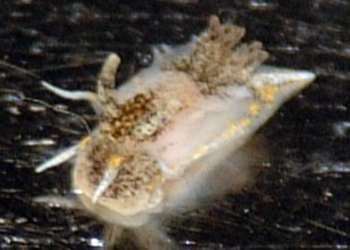
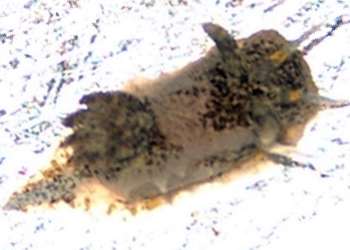
Hi Bill,
Thanks for your comments on our Cerberilla. Here is a second animal from our fisheries monitoring program in NW Florida. It was caught in trawls at depths between 2.6 and 4.1 m. The bottom in this area I believe is sand. Species were caught on Jan. 8 and Jan. 12, 2004. The area is the Apalachicola Bay, an estuary protected by barrier islands.
This one, possibly a Polycera, was only about 10 mm long. It looks like P. hummi but it does not have the blue and yellow bands along the rhinophores. We have since caught other specimens and I have not seen the bands on them either. They do however have some yellow dots along the lower mantle. I hope that helps. Let me know if you have any other questions.
Thanks,
Kelly Hooper
kelly.hooper@fwc.state.fl.us
Hooper. K., 2004 (Feb 14) Okenia? from Gulf of Mexico. [Message in] Sea Slug Forum. Australian Museum, Sydney. Available from http://www.seaslugforum.net/find/12174Dear Kelly,
You may have seen the message I posted yesterday on Polycera aurisla and P. hummi. Your animal looks a bit like both of those but in general shape it looks more to me like a goniodorid such as Okenia or Goniodoris. Perhaps if you have other photos of it which show a bit more detail I could make a better stab at identifying it, but I suspect it may be necessary to have a look at its anatomy to be sure.
Best wishes
Bill Rudman
Haminoea succinea? from Florida
December 10, 2003
From: Steve Massey and Julie Schwartz
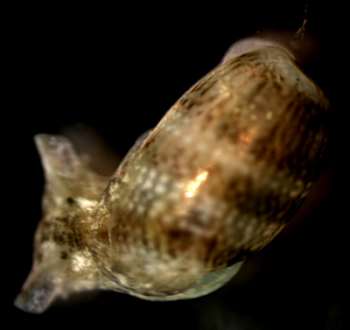
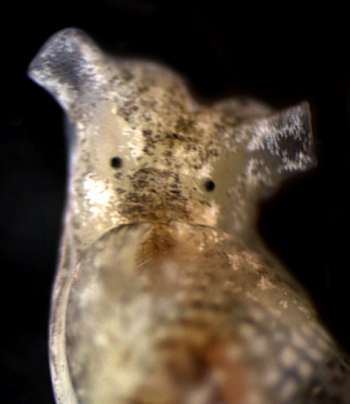
Dear Bill
We obtained what we think is a shelled slug from Tarpon Springs in Florida in September, which came into our lab on Penicillus algae. The habitat was shallow flats, some mangroves present, with large amounts of Penicillus growing. We are not sure if it is a sacoglossan (ie Volvatella) or a cephalaspidean. The shell is pliable ('bendy') and indented at the end furthest from the head. The animal is small, approx 4 mm in length. The rhinophores are short and blunt, and the head displays black and white pigmented cells. It is unclear whether the animal feeds on the Penicillus. Any help you can provide with identification will be much appreciated.
Best wishes
Steve Massey and Julie Schwartz
semassey@chuma1.cas.usf.edu
Massey, S. & Schwartz, J., 2003 (Dec 10) Haminoea succinea? from Florida. [Message in] Sea Slug Forum. Australian Museum, Sydney. Available from http://www.seaslugforum.net/find/11608Dear Steve & Julie,
I am pretty sure this is a species of Haminoea. They are herbivores so it is possible they are feeding on Penicillus. However we really don't know how specialised their food choice is so they may feed on a variety of algae, though most likely they are restricted to greens. Some species, when nothing else is around, can feed on the diatomaceous algal film found covering most surfaces in shelterd waters such as mangrove swamps.
It is posssible that your species is Haminoea succinea (Conrad, 1846), which is a species known from Maryland, Florida, Texas, and parts of the Caribbean. Most species of Haminoea have a shell which is quite rounded in appearance, whereas in H. succinea the sides of the shell are nearly straight giving the shell a cylindrical rather than 'bubble' shape. One problem is that 'bubble-shells' have been described essentially from their shells so it is difficult to be sure when you have a live animal. The shell of H. succinea grows to about 10mm, so if your animals were only 4mm long then it is most likely they are very juvenile individuals, which makes identification even more difficult.
Hopefully someone with local knowledge can give us their opinion.
• Marcus, Ev. (1972) Notes on some opisthobranch gastropods from the Chesapeake Bay. Chesapeake Science, 13(4): 300-317.
• Conrad, T.A. (1846) Proceedings of the Acadmey of Natural Sciences, Philadelphia, 3(1): 26
Best wishes
Bill Rudman
Corambe? from the Bahamas
October 15, 2003
From: Colin Redfern
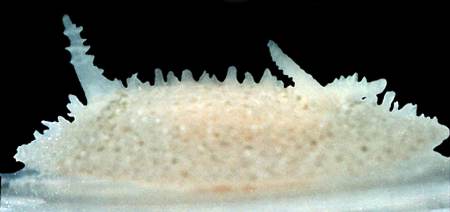
Dear Bill,
Following your comments on the photo of a Jamaican animal contributed by Ross Gundersen, I've re-examined my photos of this species from the Bahamas. Attached is an additional dorsal view of the 9mm specimen figured in Bahamian Seashells (fig. 711A). It was collected from floating Sargassum off Fish Cays, Abaco, Bahamas on June 29, 1995. Unfortunately the depth of field is poor in these photos, but I'm attaching a lateral view of the same specimen, taken on the side of a petri dish. The quality of this photo is also poor, but it certainly confirms your observation of the presence and location of dorsal gills. Thanks for pointing out that this can't be a corambid.
Best wishes,
Colin
bahamianseashells@att.net
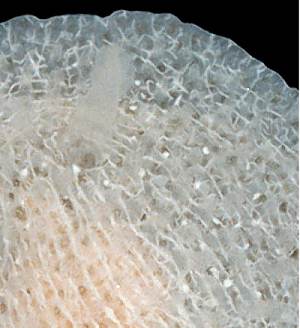
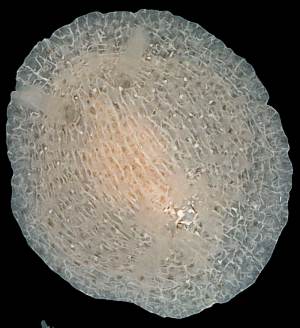
Thanks Colin,
It definitely has gills and quite distinctive papillae which would certainly fit an onchidorid. I guess it will need a look at its anatomy to be sure but it certainly doesn't appear to belong to the Corambidae.
I don't know of an onchidorid being recorded from the warm water Atlantic. We normally think of them as coldwater animals but I remember finding what I am sure is the European Onchidoris depressa in Noumea, New Caledonia [see message] which I presume had got there with shipping. It is possible therefore that your animal is a 'hitchhiker'.
Best wishes
Bill Rudman
Corambe? from Jamaica
October 13, 2003
From: Ross W. Gundersen
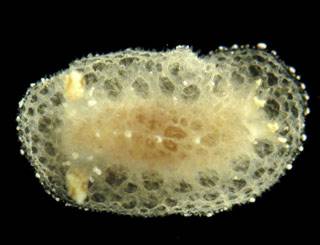
Dear Bill:
Here is another sea slug from Jamaica. As I said in my first message, all specimens were collected from St. Ann's Bay, Jamaica, West Indies. Photo: R. Gundersen.
Here is a possible species of Corambe. 4 mm in length. Found under rock on back reef at 1 m depth. Associated with bryozoans. Upper surface appears mesh like.
Best wishes,
Ross
ross.gundersen@uwp.edu
Gundersen, R.W., 2003 (Oct 13) Corambe? from Jamaica. [Message in] Sea Slug Forum. Australian Museum, Sydney. Available from http://www.seaslugforum.net/find/11107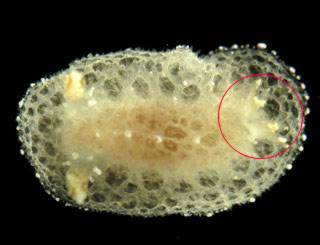
Dear Ross,
This is almost certainly the same animal as the one Colin Redfern tentatively identified as Corambe obscura (Verrill, 1870) [Redfern, 2001]. However I think I can see a circlet of gills in the postero-dorsal midline? Have you by chance another photo, or a higher resolution scan I could check? If there is such a circlet of gills then it can't be a corambid which has the gills below the mantle in the posterior midline. If there are dorsal gills it could be a species of Onchidoris which feed on encrusting bryozoans and can have quite good camouflage colouration
Best wishes
Bill Rudman
Colorful aeolid from Florida
April 10, 2003
From: Linda Ianniello
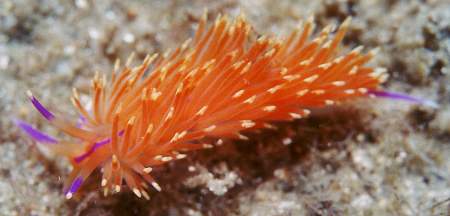
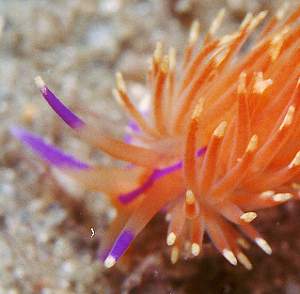
Dr. Bill,
I have no idea what this animal is; I can't find anything like it in any of my literature. It was found in Lake Worth, Florida, at a depth of about 15 feet on the local hydroids at night. The colors are absolutely gorgeous, more typical of Pacific nudibranchs than the West Atlantic. Can you identify it?
Regards,
Linda I.
lindai@us.ibm.com
Dear Linda,
It certainly is a beauty. I have no idea what it is. It is possibly a species of Flabellina but I don't know of one with these markings and smooth rhinophores. Certainly the purple markings should make it easy to identify if it has been named, except if it is one of those unfortunate species that were described from preserved decolourised specimens.
Best wishes,
Bill Rudman
Caribbean Cuthona?
October 2, 2002
From: Dave Behrens
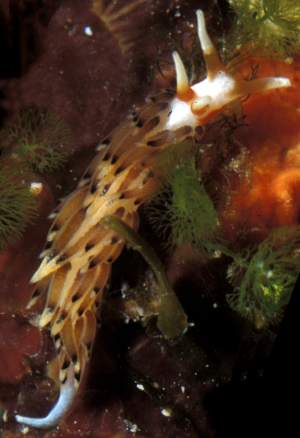
Dear Bill:
Another Caribbean unknown. This species, which I believe to be a Cuthona was collected in shallow water at Lark Cay, off Belize. The photograph wass taken by Jeff Hamann. Does anyone recognize it?
Thanks
Dave Behrens
dave@seachallengers.com
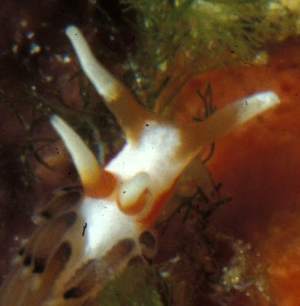
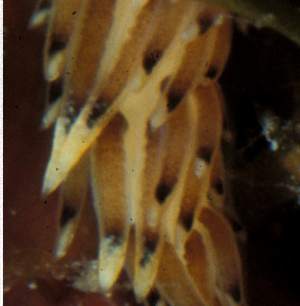
Dear Dave,
I can't be sure, but in the bottom left close-up I think I can see a tentacular anterior foot corner. If so it is unlikely to be a Cuthona. It reminds me of Phidiana indica, so my 'gut feeling' is that this is a glaucid - but that's only a guess.
Cheers,
Bill Rudman
Aplysia sp. from the Colombian Caribbean
July 5, 2002
From: Nestor E. Ardila E.
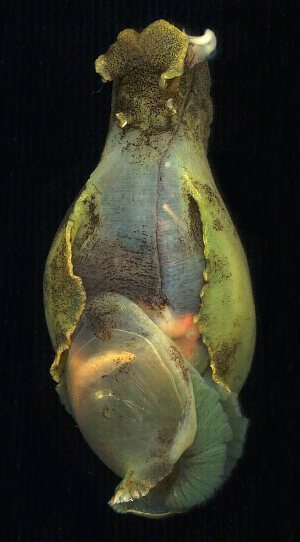
Dear Dr. Rudman:
I' ve been working the last five years in mollusks from the upper slope (200-500m) and continental shelf in the Colombian Caribbean. At present I am working some specimens of opistobranchia. Could you help me with the ID of this specimen of Aplysia sp. This specimen was collected with a bottom trawl to 150m. The total length: 50 mm and the shell length: 17mm.
In the Colombian Caribbean there are recorded only three species of Aplysia - A. brasiliana, A. dactylomela and A. cervina.
Thanks in advance,
Nestor E. Ardila E.
nardila@invemar.org.co

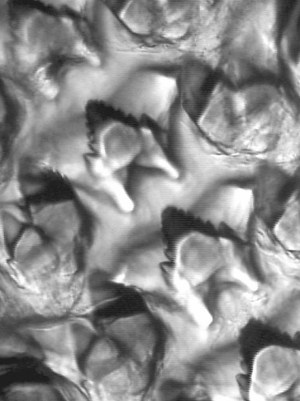
Dear Nestor,
I wish I could help but I suspect it is an impossible task at present. Marcus (1972) reviewed the Caribbean anaspideans and reported eight species of Aplysia from the region, all of which could occur I Colombian waters. While it should be possible to distinguish A. dactylomela, A. juliana and A. parvula from preserved animals, because of distinctive anatomical and colour characters, I doubt if there is any easy way to distinguish the others from preserved specimens. I am afraid out knowledge is just not good enough. Many species have been described from mishapen, decolourised preserved specimens, and even those described from live animals seldom give us enough information on variability of colour, radular morphology and shell shape, to be able to identify a species froom a preserved animal. I am sorry, but until we know the living fauna of a geographic region well, there is no way we are going to be able to identify preserved specimens sensibly.
From correspondence on the Forum there are clearly workers in Florida who are familiar with their local Sea Hares, but I don't know if there are other species elsewhere in the Caribbean. If anyone can fill in some gaps, their contributions would be very welcome.
• Marcus, Ev. (1972) On the Anaspidea (Gastropoda: Opisthobranchia) of the warm waters of the western Atlantic. Bull. Mar. Sci., 22(4): 841-874.
Best wishes,
Bill Rudman
Dendronotus sp.? from Colombia
June 18, 2002
From: Alexander Taborda M.
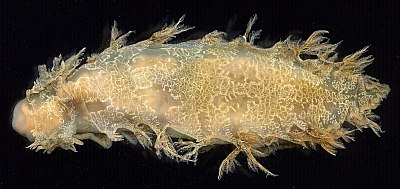
Dear Dr. Rudman,
Please, I need your collaboration in the identification this organism. Is it Dendronotus sp? I don't know the species, what is your opinion?. Collected in a botton trawl at 80 meters depth, Santa Marta, Carribbean coast Colombia.
Thanks,
Alexander.
alexandertaborda@hotmail.com
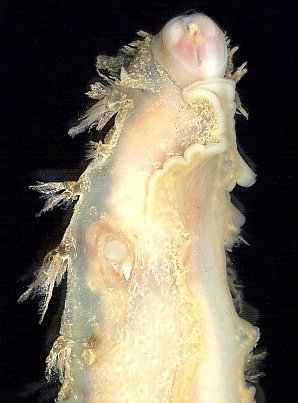
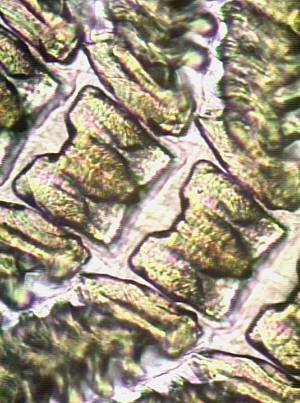
Dear Alexander,
I am sure this is not a species of Dendronotus. The tricuspid shape of the central radular tooth is very typical of the tritoniids, as is the general body shape. I don't think it is possible to identify this species from the external characters of a preserved animal, and you don't give me any idication of size, but I suspect it is probably a species of Marionia, and possibly Marionia cucullata as defined by Marcus (1983). In the lower right photo you can see the genital opening below and between the 2nd and 3rd gills, and the anus just behind the 4th gill, which is characteristic of that species. However without further information on the alimentary canal, size and colour of the living animal it is not possible to give a valid identification. From Marcus's review, I suspect a lot more needs to be known about the living tritoniids of the Caribbean before sense can be made of those that have been named from preserved animals in the past.
• Marcus, Ev. (1983) The western Atlantic Tritoniidae. Boletim de Zoologia, University of Sao Paulo, 6: 177-214.
Best wishes,
Bill Rudman
Unknown Caribbean Polycera
May 1, 2002
From: Dave Behrens
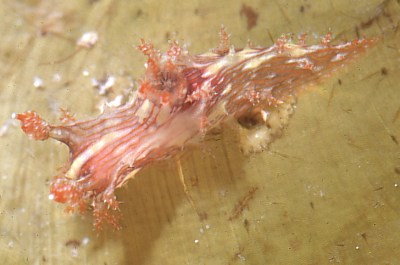
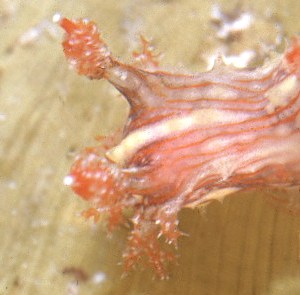
Dear Bill:
Wondered if anyone can shed some light on this Polycera collected in Belize, Central America. We collected the specimen at Laughing Bird Caye, on March 29, 1992, at a depth of about 100 feet on a filigree hydroid. The photo is by Jeff Hamann.
Thanks
Dave Behrens
dave@seachallengers.com
Behrens, D. , 2002 (May 1) Unknown Caribbean Polycera. [Message in] Sea Slug Forum. Australian Museum, Sydney. Available from http://www.seaslugforum.net/find/6509Dear Dave,
Polycera rycia Marcus & Marcus, 1970 seems to be the only Caribbean species with secondary papillae on the extrabranchial papillae, and it doesn't seem to fit that species.
Cheers,
Bill
Aeolid from from the Dominican Republic
June 18, 2001
From: Elianny Domínguez Tejo
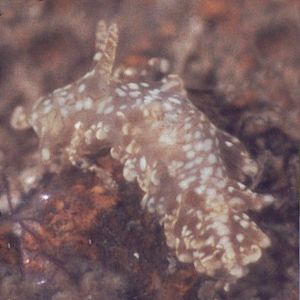
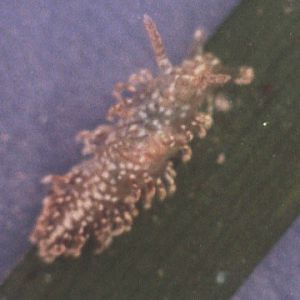
Dear Bill,
Last year I did my internship in the National Aquarium in the Dominican Republic, where I continued to search for nudibranchs. I found this one crawling over Thalassia testudinum, at 4 m of depth, in the southern coast of my country.
It is 1.5 cm long and although it is transparent, the edge of the body is light yellow. You can see the white dots all over the body and that the rhinophores have a few rings on them. The animal has many dark brown transversal lines (like the pattern of a tiger) covering all the dorsal region, but unfortunately you cannot see that on this photo.
I have put a lot of effort in finding this one, but no luck so far.... any ideas?
Cheers,
Elianny Domínguez Tejo.
elicelotte@latinmail.com
Domínguez Tejo, E., 2001 (Jun 18) Aeolid from from the Dominican Republic. [Message in] Sea Slug Forum. Australian Museum, Sydney. Available from http://www.seaslugforum.net/find/4598Dear Elianny,
It certainly looks distinctive - hopefully someone will recognise it
Best wishes,
Bill Rudman
An aeolid from Colombia
January 5, 2001
From: Phanor Montoya
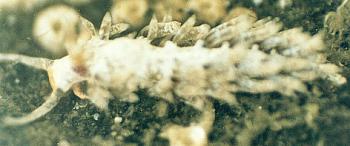
Dear Bill:
These photos aren't good but I hope they submit enough information to identify this species. All animals were collected from Santa Marta, Colombia. We found them under rocks in shallow waters [<3 m (10ft)].
The nudibranchs in these pictures were 8-10mm long. The body is white. The tip of the head is yellow. The base of rinophores is fuchsia. The ceras are kind of brown with white speckles, two rows of ceras arranged in eight groups of about five ceras. The eyes are visible besides the rhinophores.
I know the pictures aren't so good but I hope you can say something about this animals.
Thanks,
Phanor Montoya
phamont@eudoramail.com
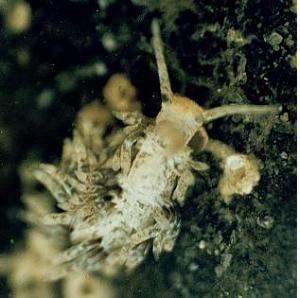
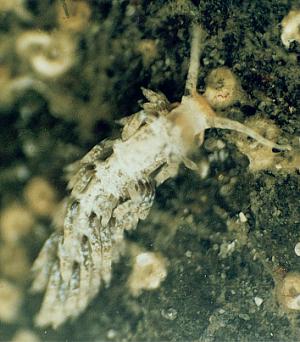
Dear Phanor,
I think if I knew the animal I could identify it from your photos but unfortunately I am not familiar enough with the Caribbean fauna to be able to name it. Hopefully someone will recognise it.
I suspect its a glaucid, perhaps Facelina or Phidiana. One useful character it would be worth trying to note when you find any aeolid is the shape of the rhinophores. Are they smooth?, have they papillae or do they have a lamellate club like a dorid.
Best wishes,
Bill Rudman
